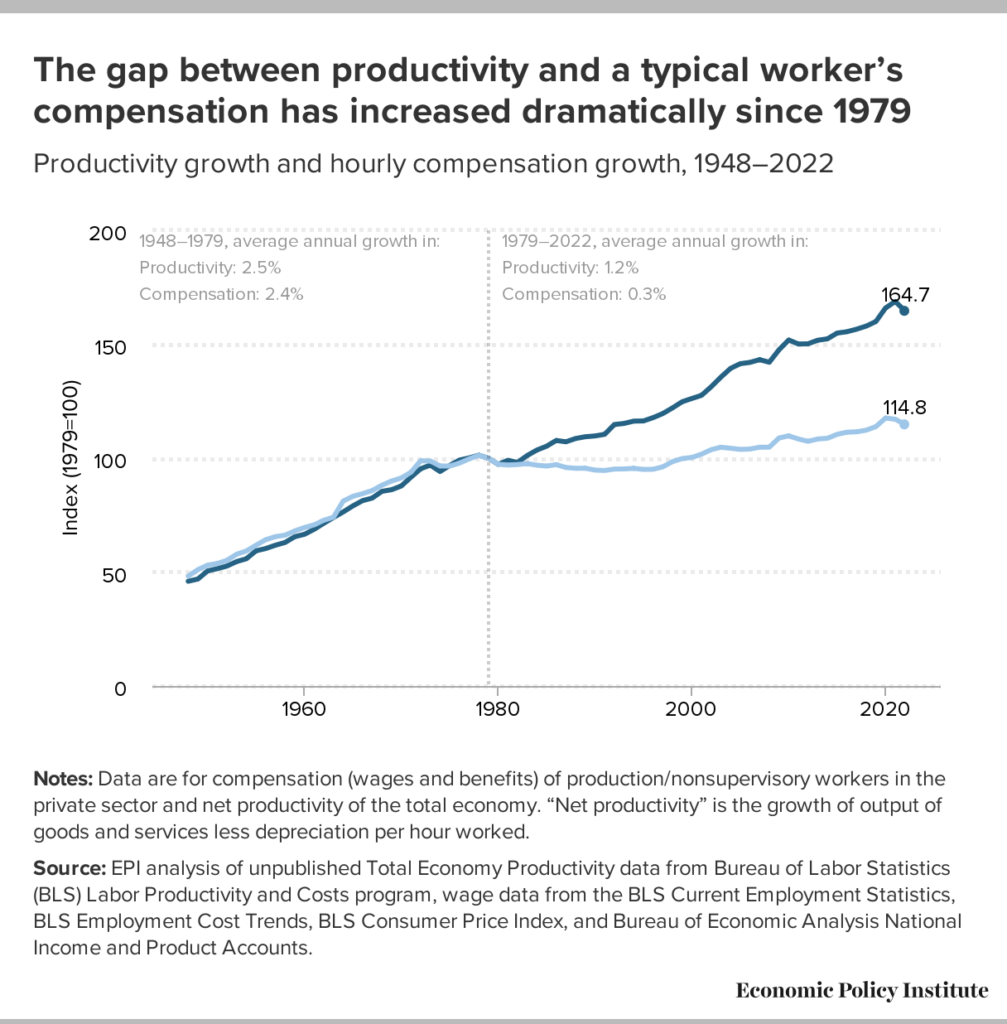
A few years ago, we could only dream about reducing the boring manual day-to-day work such as performing data analysis, writing documentation, writing content, writing code, speeding up accounting, using AI to create art, and much more. Today, if you are not using AIs for a range of purposes, you are losing valuable time and frankly, your value as an employee is depreciating at an annual rate of about 10%.
The core of my message here is that AI will enable reduced hours worked while also increasing productivity. Society’s immediate goal of the AI revolution should be a move to a four-day workweek. In this article, I explain why the natural progression is to split productivity gains between workers and companies.
Research has shown that increased productivity meant an equal increase in pay up to about the 1980s. However, since then, productivity has grown 4.4 times more than pay (in the US). EPI claims this is due to anti-worker measures being passed, which certainly is partly true. Still, I would also add that the invention of the Internet and the trend of globalization cemented the decoupling [1].

Productivity in the US increased by 64.7% between 1979 and 2022. This is a good number to keep in mind for future comparisons as 2022 was also the birth year of ChatGPT, which sparked the new generation of AIs that we mostly use today. In contrast, pay only grew by 14.8% during that time [1].
I posit that AI will be the one that will deliver even higher productivity increases, sadly we will not know the exact numbers for a few more years as that data is backward-looking. Some people expect AI to automate jobs fully, and while that may be the result of multiple decades of AI development, I think focusing on that currently is not fruitful as we are still in a phase of increasing productivity. While I believe full replacement of labor is at least a decade away, we should start preparing our society for the coming change. The best approach is to plan ahead and start with smaller steps.
I predict that within a couple of years, in many companies, people will start to run out of simple repeatable tasks that they today spend a lot of their time on due to automation. The majority of the work that will be left for them to do is ideation, creative tasks, planning, organizing, and double-checking or editing the AIs' work.
Out of these remaining tasks, ideation and creative tasks tend to deplete our mental resources quickly, leaving most people “empty” already after a few hours of intense work, until they have been able to take a significant break. Up until now, it was natural to use this “empty” state after a mentally draining and complex task by doing menial repeatable work that requires little to no mental capacity.
However, since AIs already now in many cases can reduce that work by about half, and before this decade is over it will have reduced menial work down to close to nothing, there doesn’t seem to be enough left for us to fill five workdays unless workers suddenly get forced into performing multiple roles, which obviously could happen.
Here is where the opportunity for AI to set us free emerges, it enables a societal shift to the four-day workweek. Hear me when I say this is a battle worth fighting.
Multiple studies have been conducted on the four-day workweek. One of the largest studies to date was performed in Valencia, Spain, and affected over 360,000 workers. The test showed that a four-day workweek can actually increase productivity without additional work changes when compared to a five-day workweek [2].
In a UK study, it was additionally reported that a four-day workweek improved employee retention by 57% and that workers used 65% fewer sick days [3]. Pair these findings with the advances of AI taking away large amounts of time-consuming tasks and leaving only the complex ones, and the shift to four days starts making complete sense at least for white-collar jobs.
There is close to zero chance that worker pay increases will get back to parity with productivity increases, because that would give no incentive for companies to take into use new technologies such as AI.
Instead of aiming for worker pay to productivity parity increase, society should aim to capture some of the productivity gains to reduce the work hours for the same pay. This would set a good precedent for society and individuals to start thinking about the full automation problem that will emerge later.
One of the main problems with full automation is people losing their identity and meaning. We can plan ahead and start making people comfortable with automation by making their lives easier, giving them some of their time back without a downside, and allowing them to expand themselves beyond their current identities.
[1] https://www.epi.org/productivity-pay-gap/
[2] https://www.lasnaves.com/wp-content/uploads/2023/10/Informe_4Dies_Digital-4.pdf